25 Most Common Types of Bees to Identify In Your Garden
With over 20,000 bee species in the world, you may be wondering about the different types of bees. They have a vital role to play in maintaining our planet. It is thanks to bees that we have such variety on our plates. They are necessary to pollinate the food we require to survive.
Unfortunately, bees are in decline globally because they face many threats. It is in our best interest to protect the bees and ensure their survival. With that said, let’s celebrate the good work they are already doing for us by learning a bit more about the different types of bees.
How Many Bee Types Are There?
As mentioned above, more than 20,000 species of bees exist worldwide. In saying that, there are also probably more types of bees that have yet to be discovered.
Bees can be found just about everywhere in the world that has insect-pollinated flowering plants. The only place you will not discover bees is in Antarctica.
The 7 Bee Family Types Explained
As mentioned above, there are so many different types of bees, and these various species are grouped into families. There are a total of 7 bee family types, and we will explain each of them in more detail below.
1. Apidae
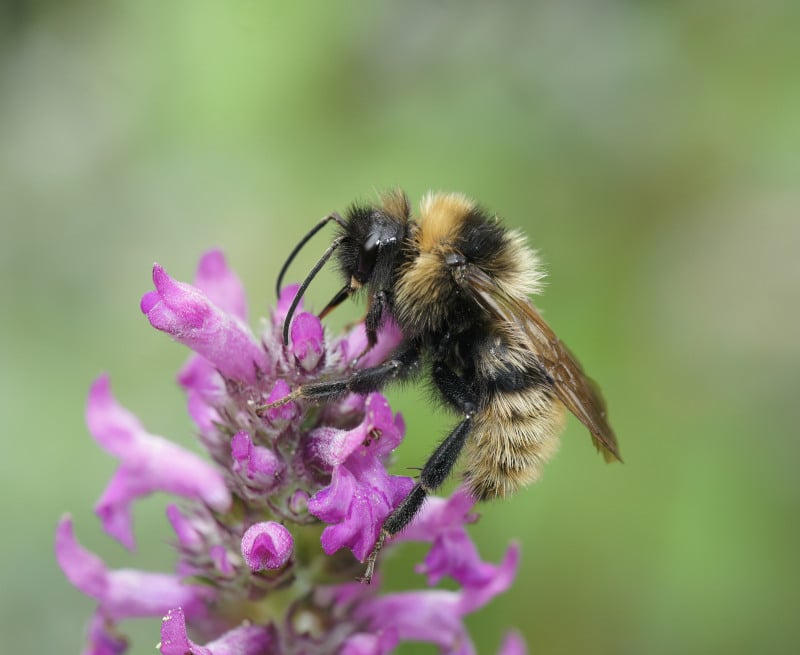
The first bee family we are going to talk about is Apidae. This family includes carpenter bees, squash bees, digger beads, and the much-adored bumble bees and honey bees.
Most of the bees in this family carry pollen on their back legs. In saying that, some species are actually cleptoparasitic and do not carry any pollen.
What this means is they steal the nest provisions of other bees. It is also important to mention here that this large group of bees has a broad range of behaviors, nesting habits, and life cycles.
2. Andrenidae
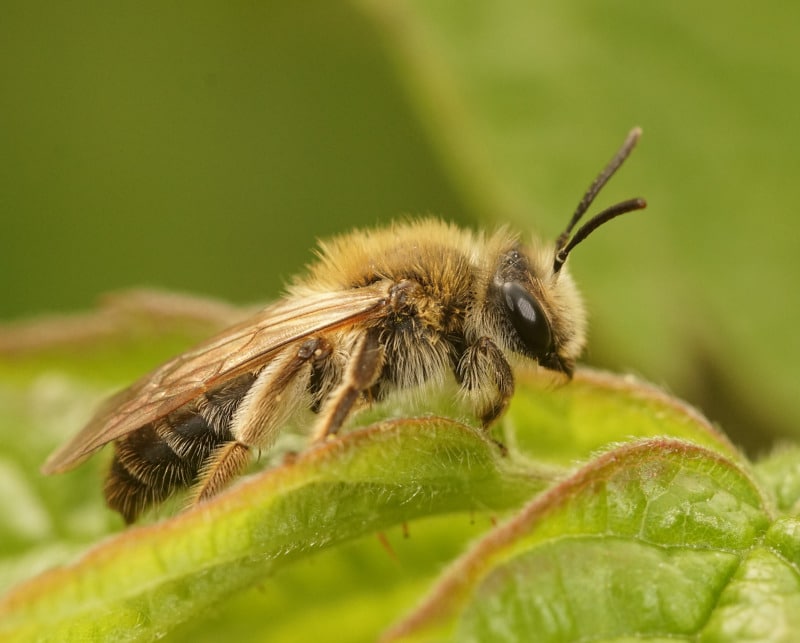
The Andrenidae family includes mining bees. Just as the name suggests, all of these bees live underground. They, too, carry pollen on their back legs. However, most of the species within this family group are not capable of stinging.
3. Halictidae
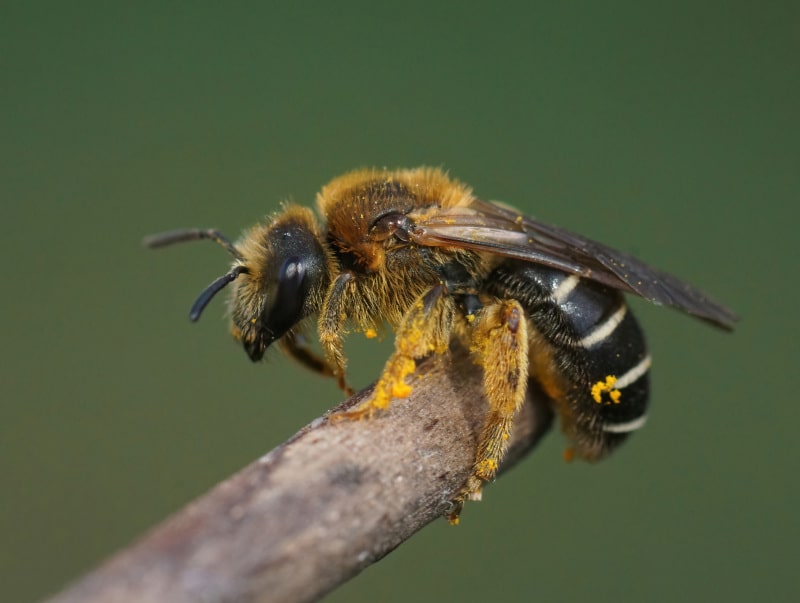
The Halictidae family consists of the sweat bees. It is a big and varied family, including bees that are interestingly attracted to human perspiration.
In saying that, some of the family members in this group are not. Most of the bees in this group vary. In other words, some nest in wood while others nest in soil.
Similarly, some live and thrive in groups, while others are solitary. In addition, some of the bees in this family are cleptoparasitic, and some are not.
4. Colletidae
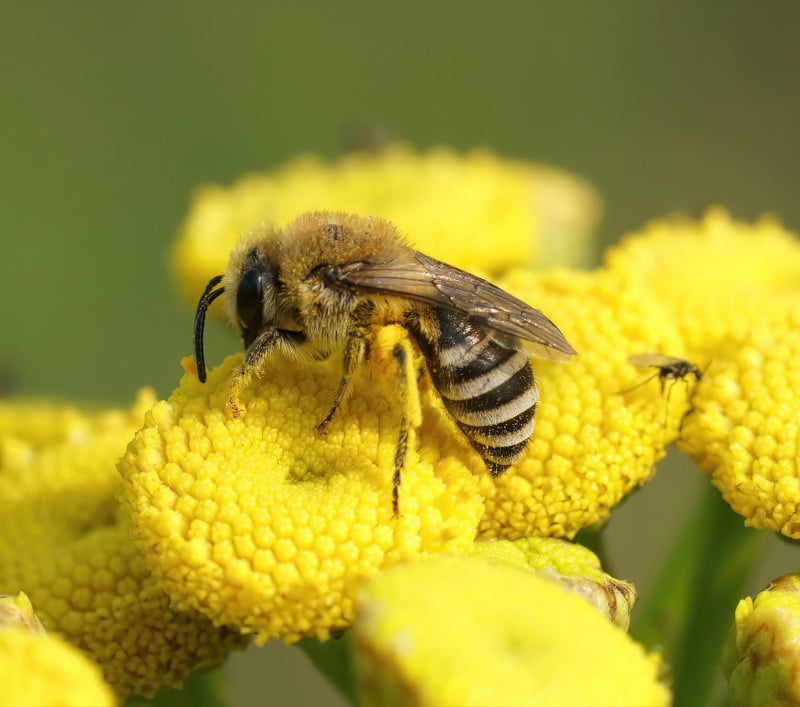
This bee family includes polyester bees, yellow-faces bees, plasterer bees, and cellophane bees. Most of the bees in this family live in hollow stems or in the ground.
All of the species line their nests with a substance similar to plastic which they secret from their abdomens.
The female bees in this group carry the pollen back to their hives inside their bodies rather than on the outside of their bodies.
5. Melittidae
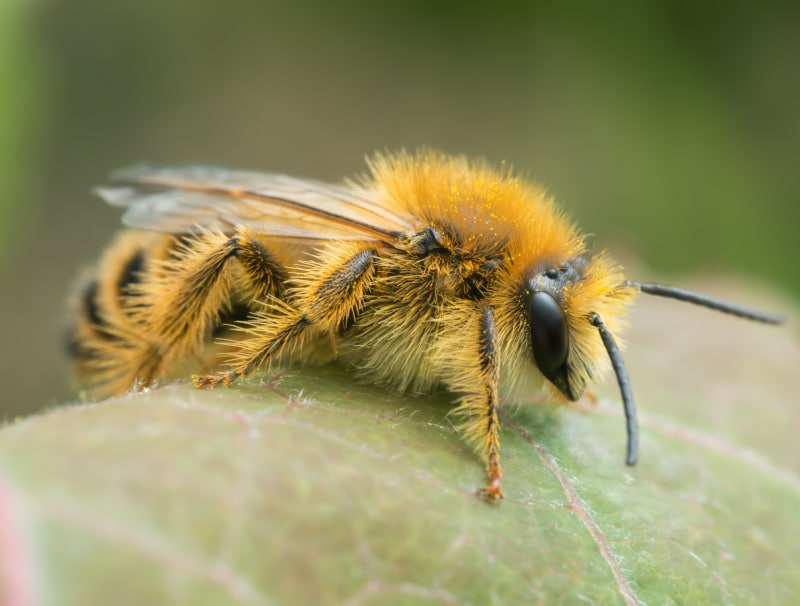
The Melittidae bee family is rather small and consists of oil-collecting bees. These oil-collecting bees nest in the soil in dry regions.
They collect oil from a variety of different plant species. They then mix the pollen with the plant oils instead of using nectar. This then creates larval food stores.
6. Megachilidae
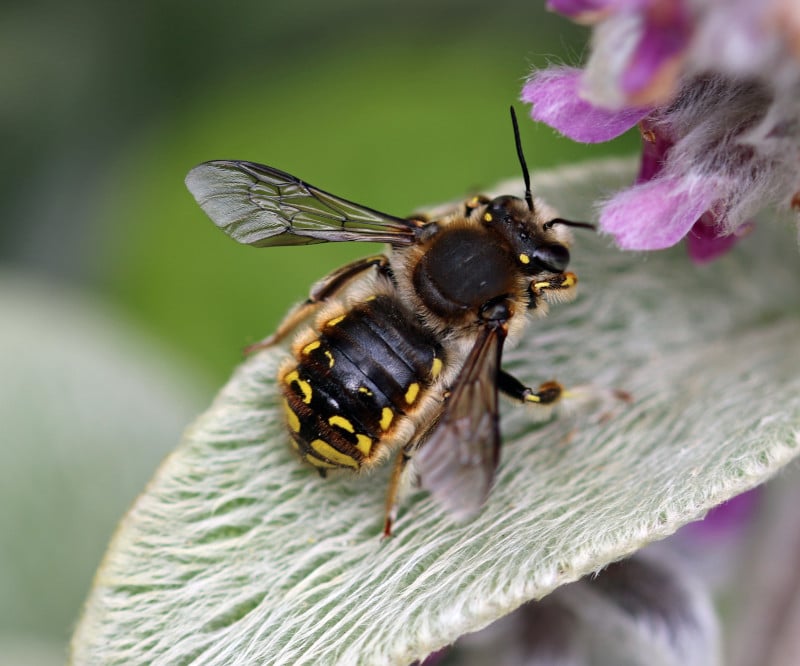
The Megachilidae bee family consists of leafcutters, resin bees, mason bees, and carder bees. These bees carry the pollen on their abdomens rather than in pollen baskets.
Additionally, they create their homes by bringing the construction materials straight to the job site. They use a range of different materials to build their nests.
It mostly depends on the specific species. Some of these materials include resins, plant fibers, mud, and leaves. They use the materials to create their nests in pre-existing cavities or holes.
7. Stenotritidae
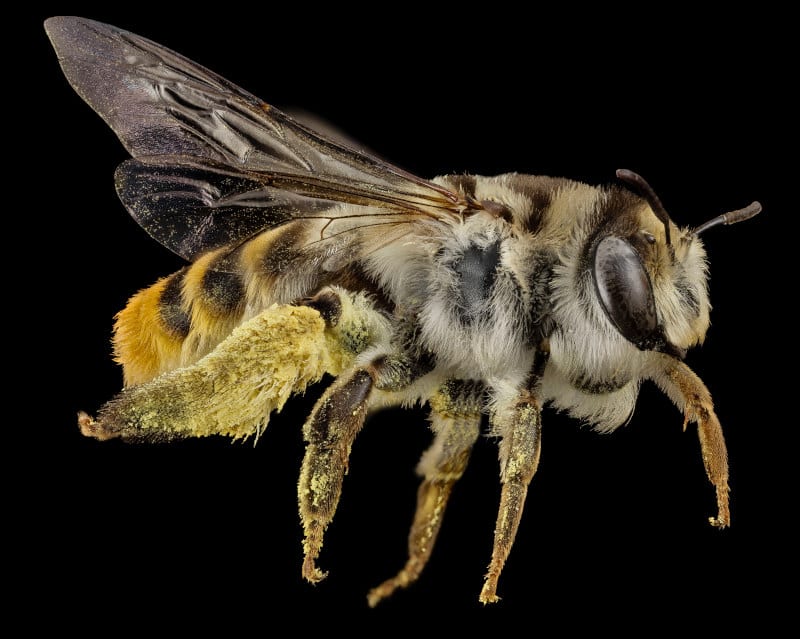
The Stenotritidae bee family is small and will only be found down under (in Australia!). The bees are solitary, fast, and big. They build cells lined with a secretion that is plastic-like and nest in burrows.
The larvae are fed provisions of nectar and pollen. Interestingly, the larvae of the Stenotritidae family do not spin cocoons.
How To Identify Different Types of Bees
Identifying different types of bees can be a challenging job which is why we are sharing some tips to help you below. People often mistake wasps for bees or even insects.
1. Check the Antennae
If you are confused about whether you are looking at a bee, have a look at its antennae. Generally, wasps will have longer and thinner antennae than bees will.
2. Look at the Coloring
Another key indicator here will be the coloring. Typically, wasps are more brightly colored than bees and have starker markings than others.
3. Look at their Body
Bees are often a lot bigger and rounder than wasps and other insects, so be sure to check out their body when trying to identify them.
4. Check out the hair
Another way to determine whether you are looking at a bee, wasp, or other insect is by the hair. Wasps, for example, generally do not have much hair, and it is often quite sleek. By contrast, bees are rather fluffy and have more hair.
The best way to determine the species of bees you are viewing is to observe their size, color, habitats, and shape. Identifying bees can be rather difficult because the different types of bees do often have similar characteristics.
Some are easier than others, for example, a bumble bee and a honey bee. However, carpenter bees are very similar to bumblebees and, as a result, are often mistaken.
The color of bees generally also varies from species to species. In other words, most honey bees are generally tan or brown in color.
By contrast, carpenter bees are typically mostly black. Interestingly, there are even some bee species that have green metallic coloring. Not to worry, though; we’ll be sharing some of the most common types of bees below, which should help you when identifying your next buzzer!
25 Different Types of Bees
Now that you know a bit more about the different bee families and how many of these fantastic creatures are roaming the planet, let’s talk about some of the most common types of bees.
Below we will break down 25 different types of bees, sharing some key features of each.
1. Bumble Bees

We’re going to kick off with one of the most common bee types that all readers are likely familiar with: bumble bees! Bumble bees belong to colonies, and they are usually pretty small.
A colony of bumble bees will generally include around 120 to 200 workers. They belong to the Apidae bee family and are quite social.
Bumble bees are incredible pollinators that roam gardens collecting pollen. They have furry bodies and are very big and round in shape.
In saying that, there is also a parasite species of bumble bees known as cuckoo bumble bees. These bees inhabit the nests of other bumble bee hosts.
2. Honey Bees
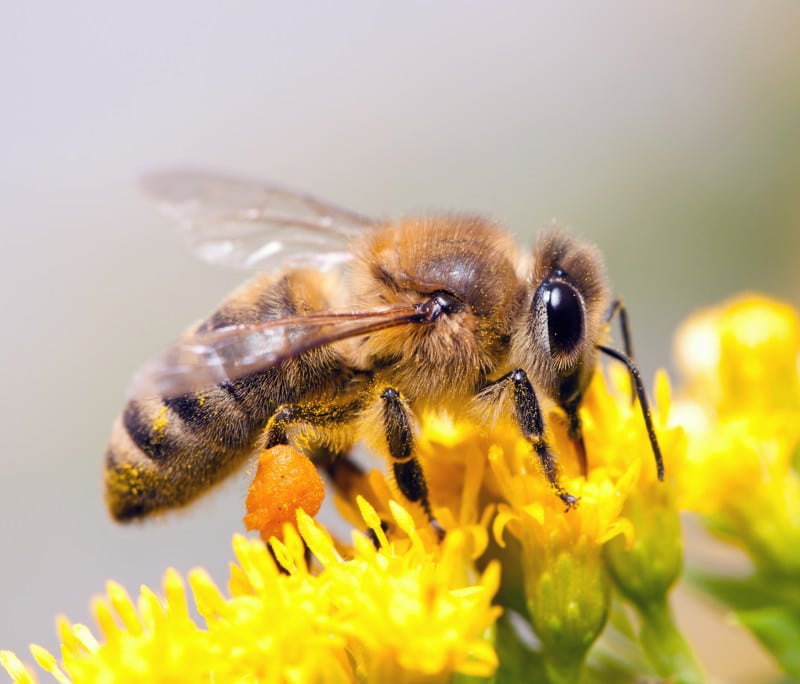
You’ll likely know this bee type very well, too: the honey bee. They are also social bees and reside in big colonies of between 50,000 and 60,000 workers. See, 120 to 200 was small!
They are one of the most commonly kept by beekeepers in hives. This is because beekeepers can easily harvest their delicious honey.
Honey bees in the wild nest in natural caves, large crevices, and tree trunks. In saying that, they, too, can find their way into man-made structures like chimneys.
These bees, along with other types of bees, play a vital role in putting nutritional goodness on our plates. Honey bees can forage even in very cold temperatures when other bees are absent. They belong to the same family as bumble bees.
3. Mason Bees

This bee type you may or may not have heard of previously. They are known as mason bees, and they belong to the Megachilidae family. Additionally, mason bees belong to the Osmia.
The name translates to odor because they mark their nest entrances with their scent. There are roughly 500 species of Osmie that have been identified across the globe.
Mason bees are solitary, tunnel-nesting pollinators that generally use clay or mud to seal the openings of their homes. They are not social like honey bees and, as a result, have a complicated relationship within their colonies.
These types of bees are quite small and have several varieties. For example, the Orchard Mason Bee is a stunning metallic green color, almost looking like a common housefly.
4. Plasterer Bees
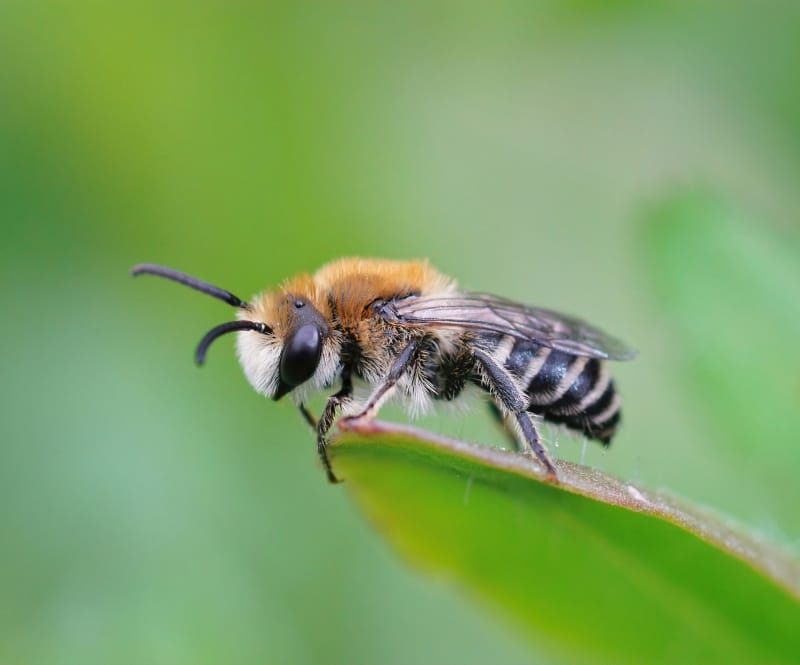
Plasterer bees belong to the Colletidae family and are referred to as polyester bees or cellophane bees. This is because they are notorious for lining and creating their nests with a waterproof substance.
They are one of the most species-rich families having approximately 2,000 species. These kinds of bees are discovered globally but are most common in Australia and South America.
As a group, they are primitive and solitary. They are some of the oldest bees on the planet, and the females care for the young bees all by themselves.
These bees are very diverse, with species ranging from big and small, hairless and furry but are rather docile, rarely ever stinging.
They receive their name because they secrete liquids from their mouths and utilize them to plaster the walls of their nests.
5. Leafcutter Bees
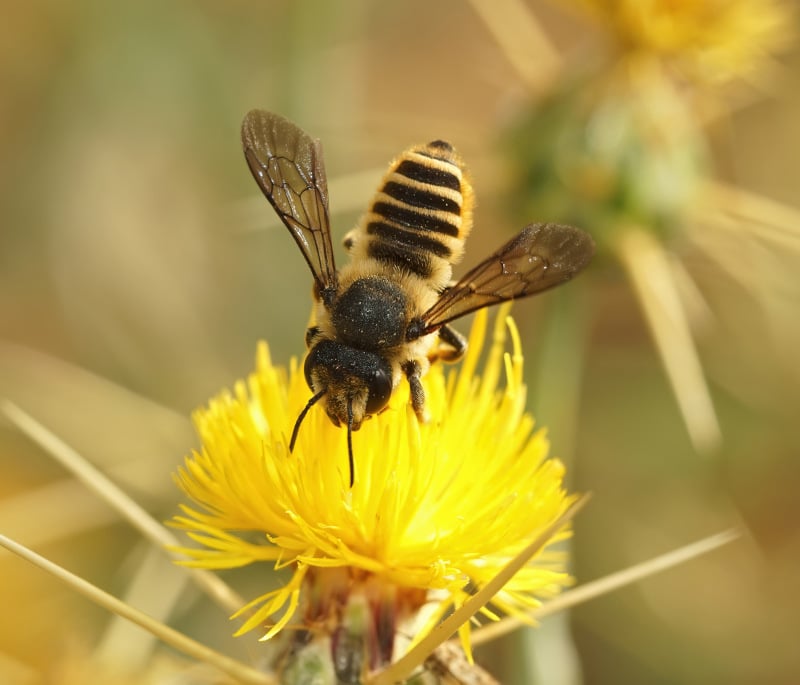
Leafcutter bees are a part of the Megachilidae family also. They cut neat segments of petals or leaves using their jaws. Then, they return to the location of their nest and use the pieces to construct their egg cells in hollow plant stems and existing crevices.
They are commonly found in gardens and lots of other environments.
You may even find them putting your bee hotel on the tree to use. They are solitary species and are incredibly fascinating to watch. They offer an invaluable pollination service for plants.
At first glance, they are often mistaken for honey bees or even hoverflies. However, one big identifying factor is how they collect their pollen. They collect it on their hairs on the underside of their abdomens.
6. Mining Bees
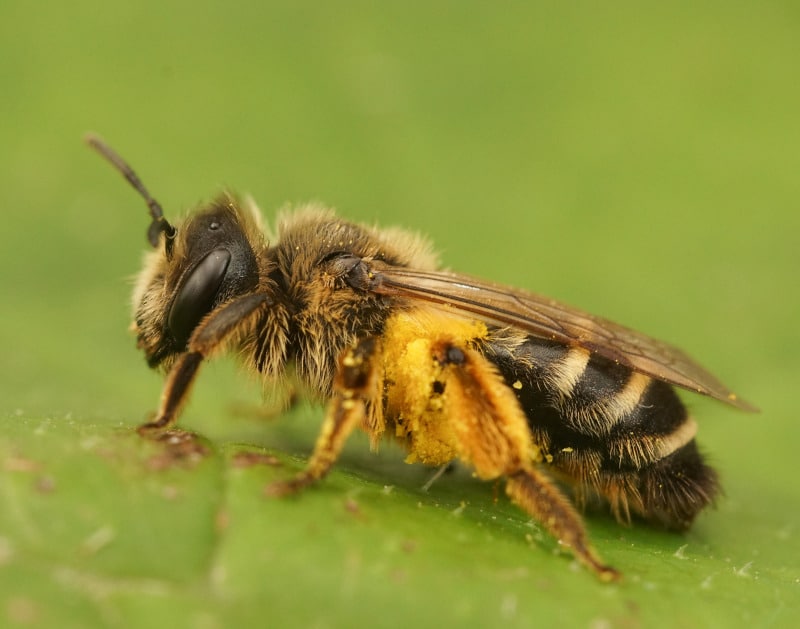
Mining bees are a part of one of the biggest bee families, with approximately 1400 identified species. That family is the Andrenidae bee family, which is Greek for buzzing insects.
These bees are solitary, and the females typically build nests in close proximity to one another. These types of bees are vital for the pollination of crucial crops.
For example, much-loved fruits like apples, blueberries, and cranberries. They live in cells underground and excavate tunnels.
You may be lucky one day to discover small mounds of earth in borders and lawns that look similar to worm casts. Don’t fret; this could mean you have mining bees in your garden. However, they do typically have a preference for sandy soil.
7. Large Carpenter Bees
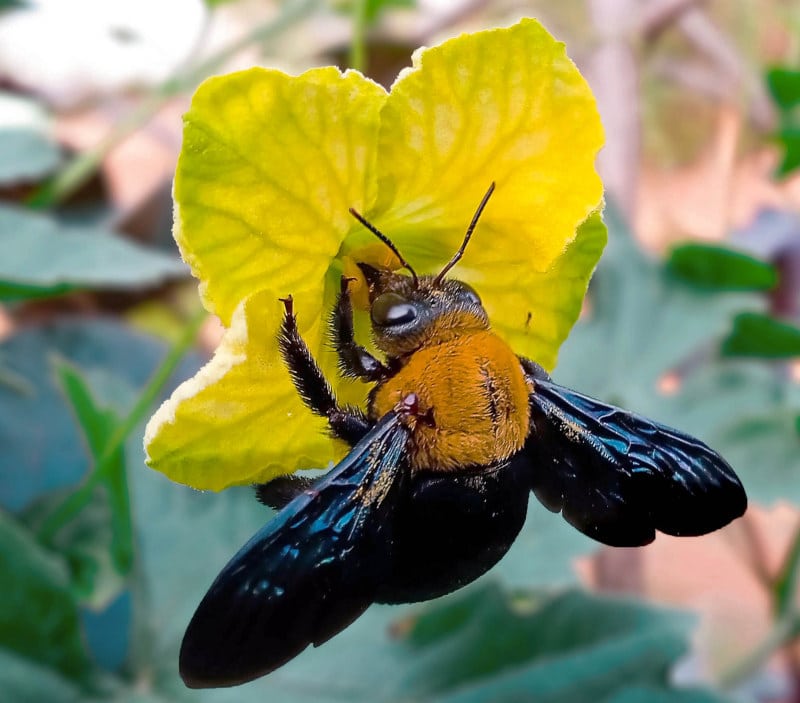
Carpenter bees are known for their large size and are members of the Apidae bee family. They are burly bees and are part of the Xylocopa species, of which there are 500 globally. This species of bees can be discovered in tropical areas in Canada, Europe, and the US.
Xylocopa is Greek for woodworker which is quite fitting since they make their nests by chewing tunnels into wood. They are sometimes mistaken for bumble bees when spotted roaming through gardens.
Their body is mostly black, but they have almost a turtleneck of fuzzy yellow hair around their neck. Their hair is almost a golden-ginger color.
8. Flower Bees
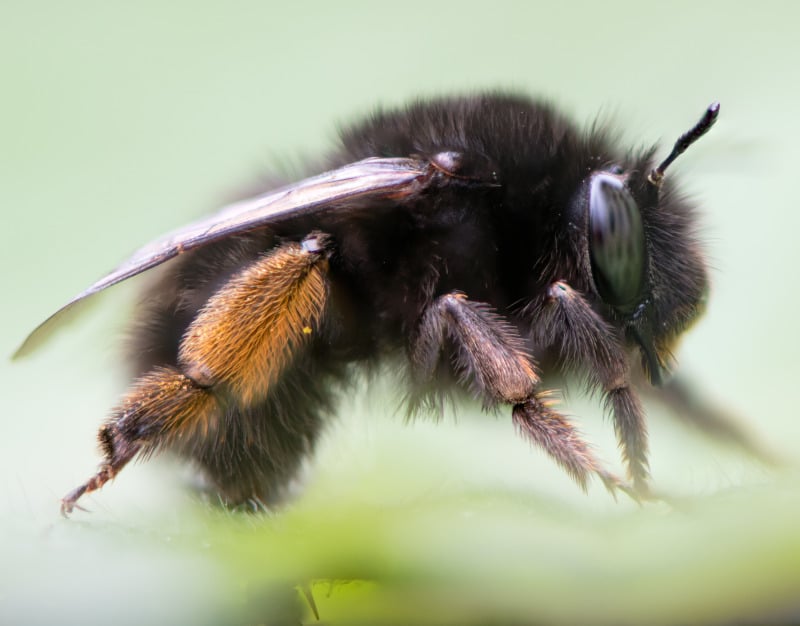
We know what you are thinking right now: aren’t all bees flower bees? They are indeed, but this type of bee, in particular, managed to coin the name! T
hey are a part of the Apidae family and belong to the Anthophora species, which is Greek for flower bearer. These bees are not afraid of cold weather, coming out to forage in early springtime.
9. Wool Carder Bees
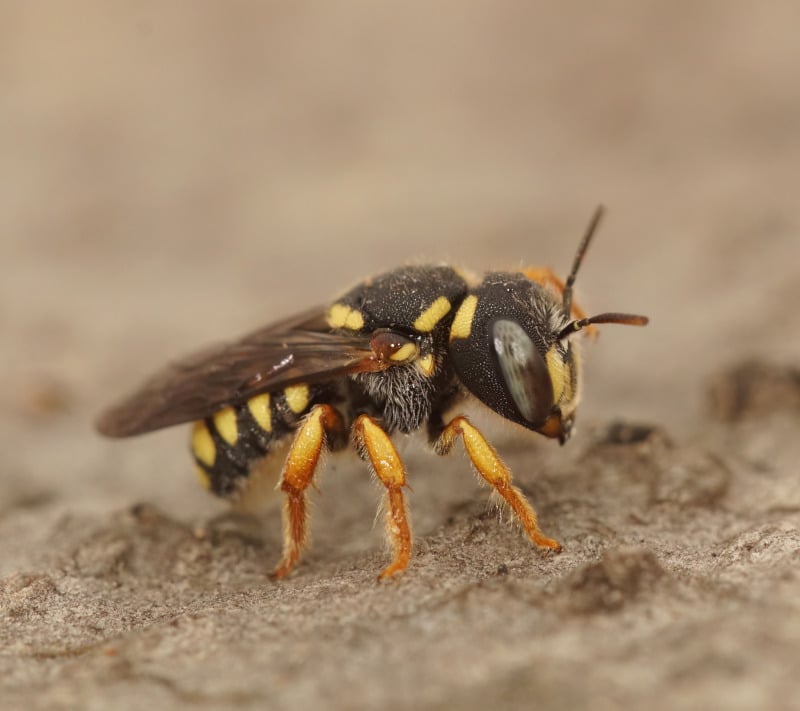
Wool Carder bees belong to the Megachilidae family and belong to the Anthidium species. They gather hairs from plants and roll them into balls for use to build their nests.
These types of bees are often mistaken for wasps due to their body markings. Globally, there are roughly 160 known species.
They are incredibly distinctive, with yellow spots down the sides of their abdomens. Additionally, Wool Carder bees are one of few where the males are actually bigger than the females.
The females look after the wool collection while the males guard areas of these plants for potential mates. Interestingly, they do not have a sting. In saying that, their tails do have several spikes!
10. Nomad Bees
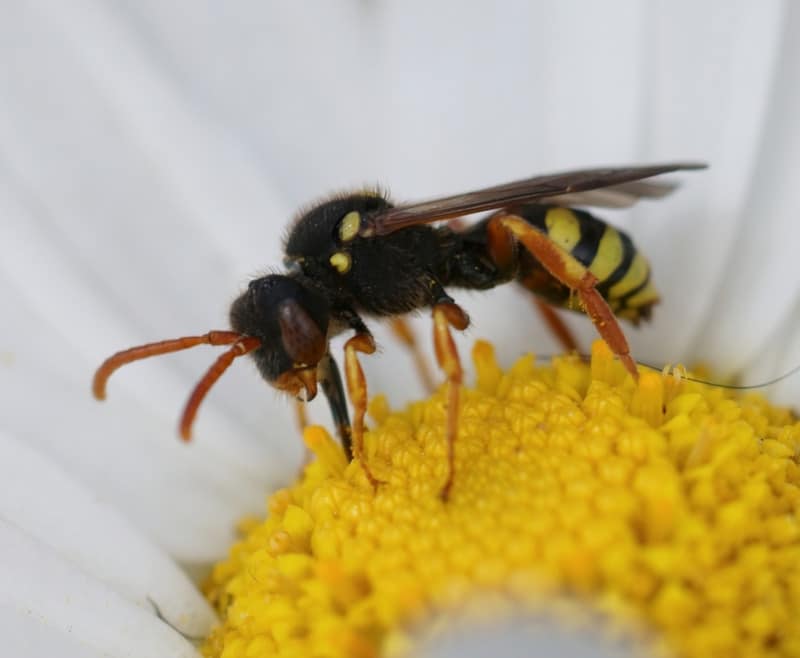
Similar to Wool Carder bees, Nomad bees are also commonly confused with wasps. They are a part of the Apidae family and are the Nomada species.
In addition, they are cleptoparasites. This means they generally attack the nests of bees. They are quite easy to spot due to their distinctive features. In addition, when they are flying low around nest burrows. There are roughly 700 known species globally.
The females use olfactory and visual cues to detect suitable host nests. When she locates a suitable one, she lands nearby and rests toward the entrance. Then, she enters the nest lays an egg in the wall of a single cell, and retreats.
The host bee will then continue to provision the nest cell with food and, eventually, seal up the cell. The larvae that hatch from the egg have large jaws that are used to destroy the grub of the host bee.
11. End-banded Furrow Bees
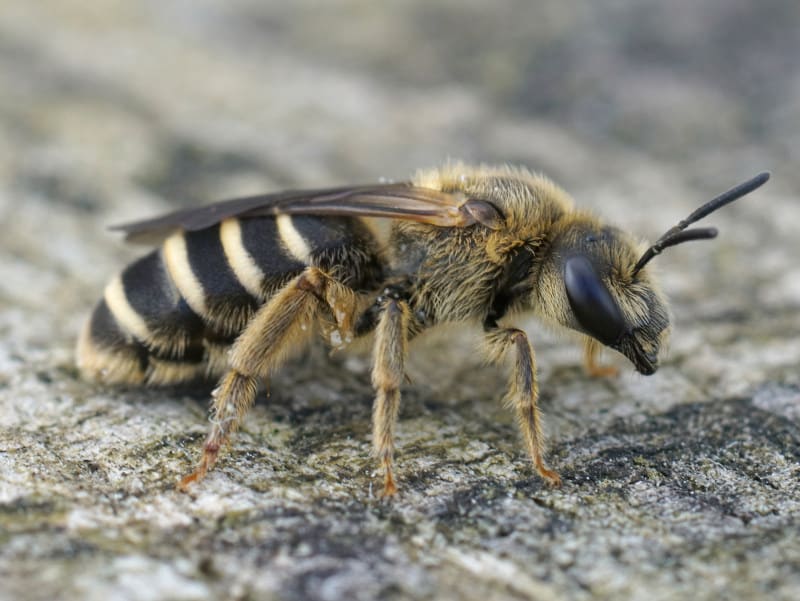
There are more than 300 species of furrow bees worldwide. The End-banded Furrow bees belong to the Halictidae family and are a part of the Halictus species.
In some areas, this species of bees is known to drink sweat from humans. For this reason, they are sometimes referred to as sweat bees.
Halictus is Greek for collecting or gathering. These bees have a distinctive striped appearance and are generalists.
You will often find them foraging on wildflowers like thistles and knapweed in your garden. Their bodies are mostly black, and they have brighter yellow legs.
12. Long-horned Bees

The Long-horned Bees are members of the Apidae family. They are the Eucera species of bees. This Greek word translates to well-horned, which is quite fitting given their appearance.
As the name suggests, these bees have large horns. Additionally, they have a mostly yellow body that is quite furry. The long antennae are particularly present in the male long-horned bees.
There are around 400 species of them known globally. They show up in a range of different habitats, from brownfield areas to woodland rides, heathland edges, and soft cliff faces.
These types of bees feed on a wide range of flowers like bugle, comfrey, and bramble. Unfortunately, they are one of the bee species in quick decline and have been labeled a priority.
13. Yellow-faced Bees
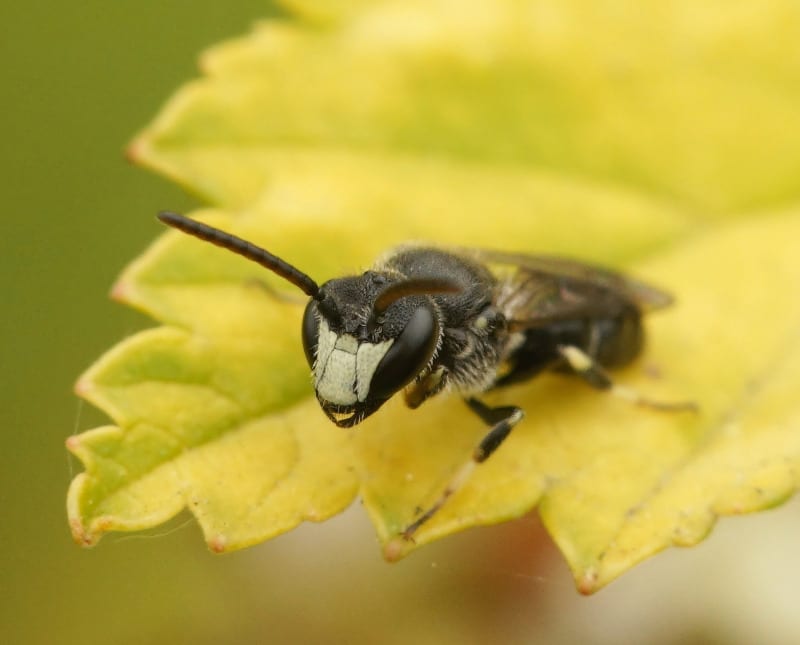
You can probably guess what these bees might look like based on their name. Yellow-faced bees are quite enchanting looking. They are small with yellow faces and mostly black bodies.
These bees are part of the Colletidae bee family and the Hyleaus species, which is native to Hawaii. However, they can still be found globally in the UK and North America.
They line their nests with a silk-like substance. They are solitary creatures, generally nesting in pre-existing holes or tunnels in stems or wood.
They are incredibly distinct looking and are mostly tiny and small. Similar to the Long-horned bees, they are also categorized as endangered.
14. Pantaloon Bees
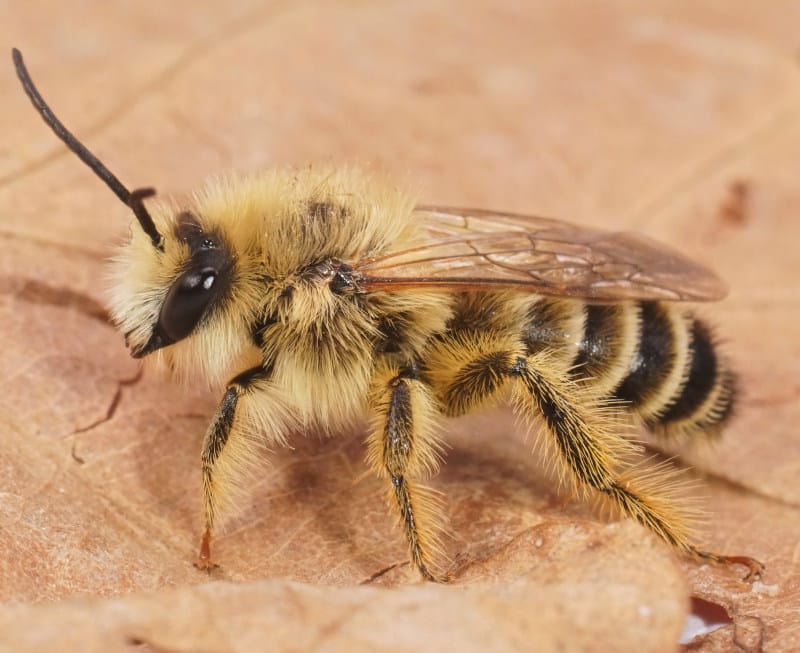
The Pantaloon Bees are members of the Melittidae family and Dasypoda species. The females of this species have incredibly long pollen-collecting hairs on their hind legs.
They like to nest in sandy areas and are often witnessed foraging on knapweeds, yellow composite flowers, and thistles.
These bees are rather striking to look at and, as a result, very easy to identify. However, the males are not as obvious. They have long golden brown hair on their bodies but similar banding to the abdomens of the females.
In addition, they have longer than normal hair on their legs. The only thing is they do lack the distinctive pantaloons the females have.
15. Resin Bees
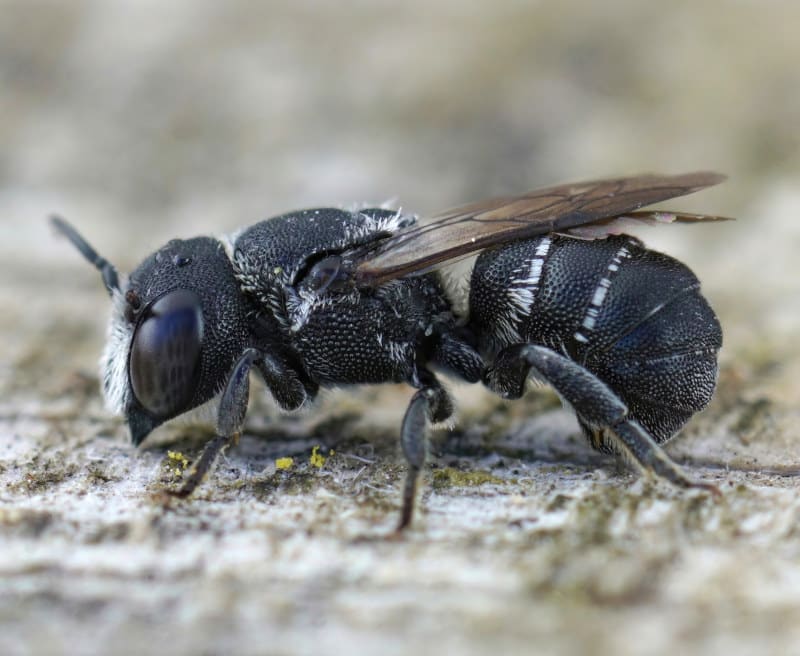
Have you ever seen a black bee? Here’s your chance with the Resin Bees. They are members of the Megachilidae family and the Heriades types of bees. They are small and black.
Due to their coloring and size, they are often mistaken for small black flies. The female Resin Bees have hairy pollen brushes on their abdomens and a slight curve to the tip of their abdomens.
These bees can be discovered in a wide range of habitats across the world. From America to Japan, India, Africa, Europe, and the Pacific Islands, you are sure to spot Resin Bees.
They get their name because they collect resins from trees. The trees they choose are typically pines, and they use these resins to make their nest cells.
16. Sharp-tail Bees
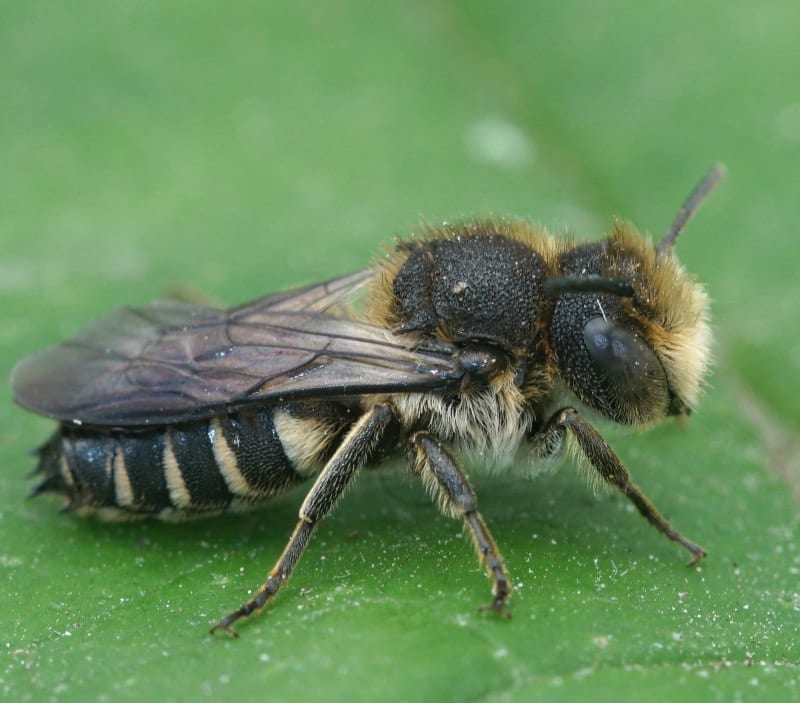
Just like honey bees, Sharp-tail Bees, too, have hairy eyes. However, there is one thing they have that honey bees do not. Can you guess? It’s a sharp tail!
These bees are cleptoparasites which means their females lay their eggs in the nests of solitary bees. Their young then eat the food stores that are intended for the offspring of the host.
They are very easy to spot with sharp tails and grey coloring. These bees belong to the Megachilidae family and are the Coelioxys species.
They like to visit a wide range of flowers from bird’s-foot-trefoils to mallows, knapweeds, white bryony, and marjorams. There are more than 500 species of them globally.
17. Dark Bees
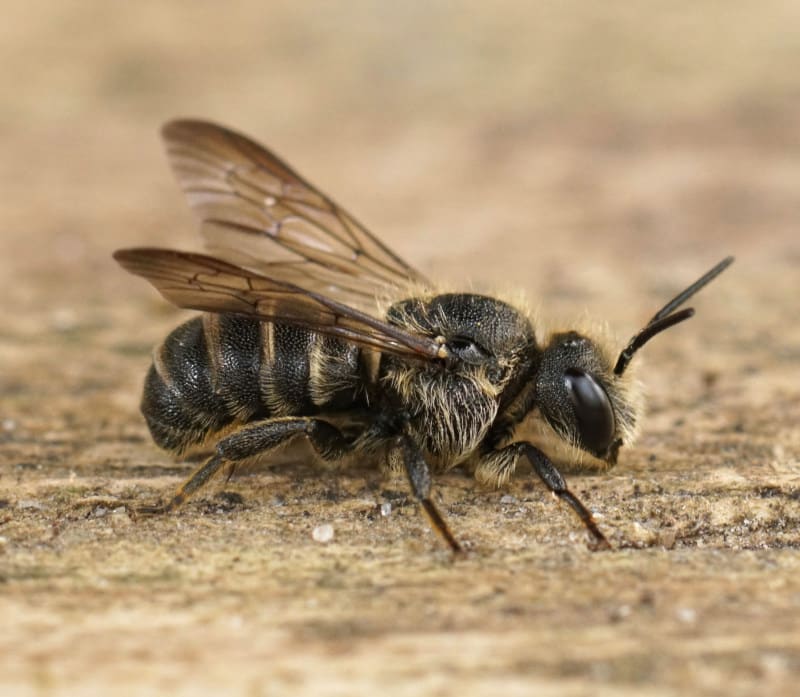
We’ve had black bees, so it seems only right to delve into Dark Bees. As the name suggests, they are almost grey or black in color.
Dark Bees are members of the Megachilidae family and are the Stelis species. They are small to medium-sized bees. In addition, they are also cleptoparasitic bees and target a wide range of bee species. These include resin bees, scissor bees, and mason bees.
18. Scissor Bees
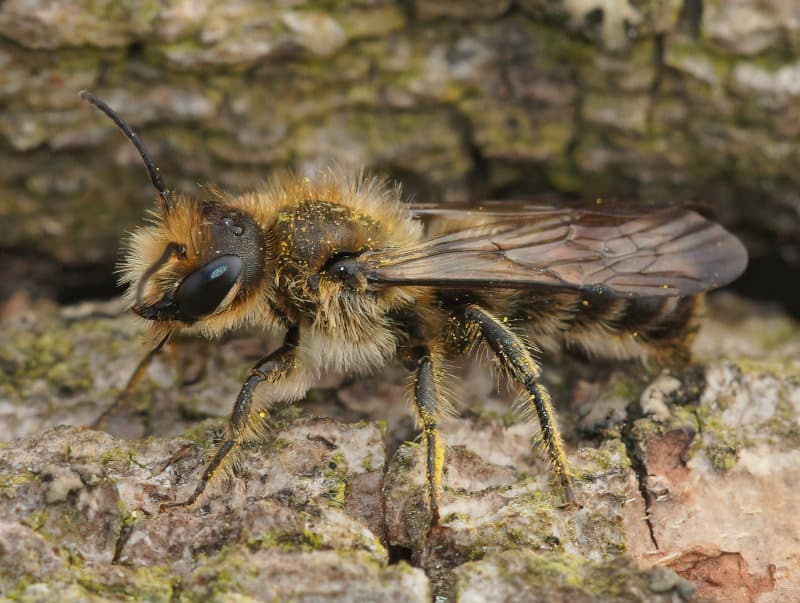
Scissor bees are small to medium size bees. They are slender and create their nests from pre-existing cavities and holes that can be found in empty beetle crevices in walls and wood and hollow plant stems.
They forage on a limited range of flowers. These bees have a dark coloring with pale, yellowish hair under their abdomen and yellowish hairs on their legs.
Scissor Bees are a part of the Megachilidae family and the Chelostoma species. They are renowned as Britain’s smallest bee species. These bees are just six to seven millimeters in length.
They have shiny black bodies that are topped by a large head. In addition, Scissor Bees are solitary, and there are around 60 species of them globally.
19. Small Carpenter Bees
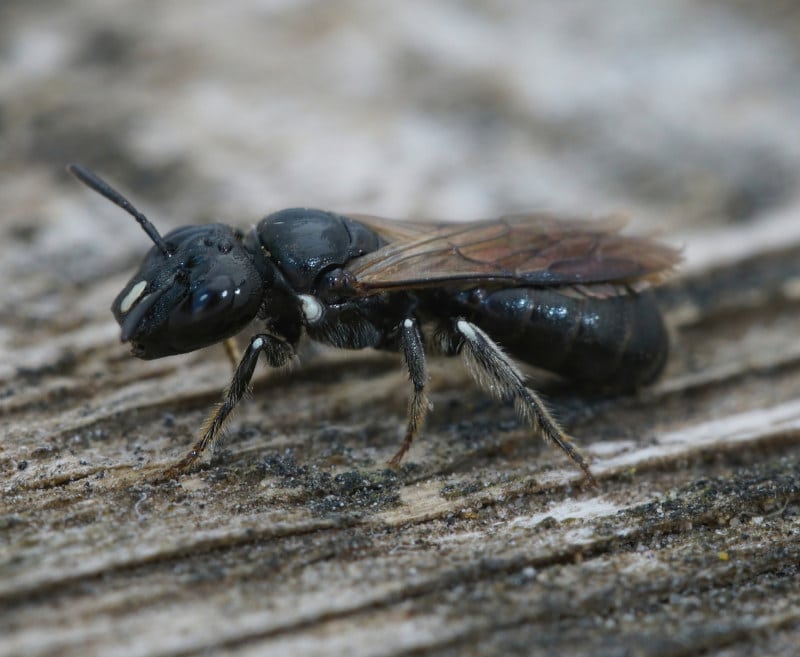
We’ve talked about Large Carpenter Bees, now let’s explore Small Carpenter Bees. They are members of the Apidae family and the Ceratina species. These bees are very distinctive looking, having a metallic green body and brown wings. Additionally, they are virtually hairless. These types of bees are generally small to medium.
They can be discovered everywhere besides Antarctica, and there are over 350 species of them globally. To answer your burning question, yes, they are related to the larger carpenter bees, too. These bees enjoy foraging on a wide range of flowers.
20. Blood Bees
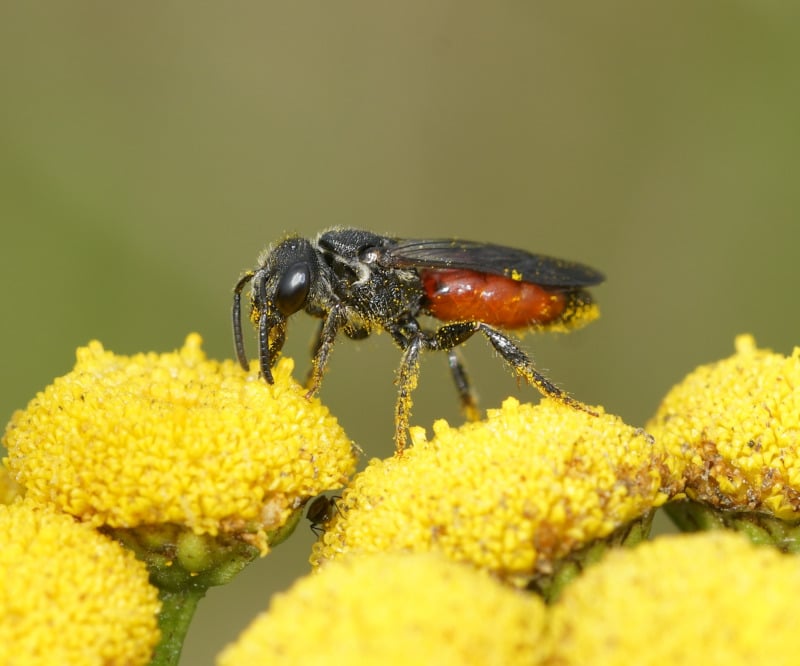
Blood Bees are another kind of kleptoparasitic bees. They have blood-red colored abdomens and target the nests of ground-nesting bee species.
These include bees from the Lassioglossum, Andrena, and Halictus species. They are a part of the Halictidae family and are known as the Sphecodes species.
At first glance, many could easily mistake these bees for non-parasitic species that have similar red abdomens. For example, the Small Scabious Mining Bee or Andrena Marginata or the Red-girdled Mining Bee or Andrena Labiata.
21. Mourning Bees
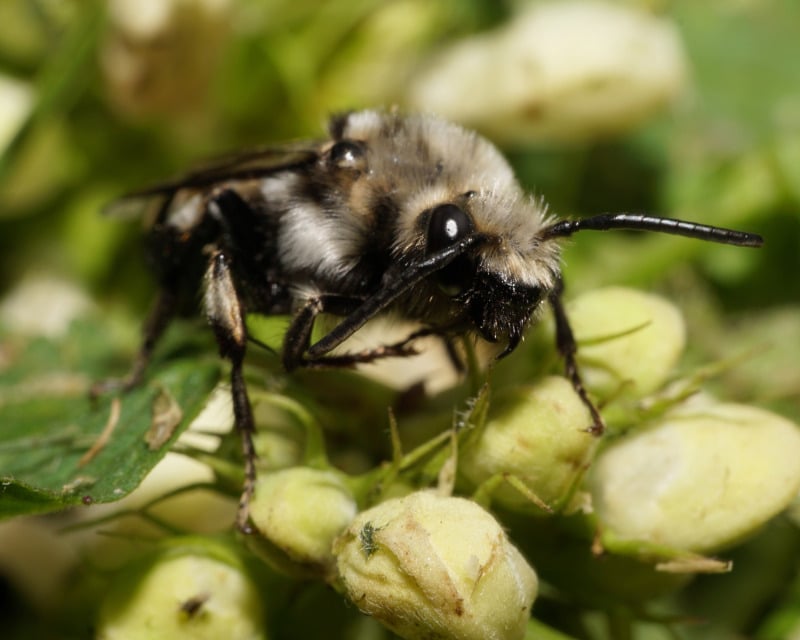
These bees are another cleptoparastic bee type, and they target the nest of flower bees. They are members of the Apidae family and the Melecta species. They are very striking looking, with white spots trailing down the sides of their abdomen.
The females are very big with mainly black coloring and a collar of golden hair. Male Mourning Bees are almost identical in appearance but are a bit smaller and less bulky overall.
22. Blunthorn Bees
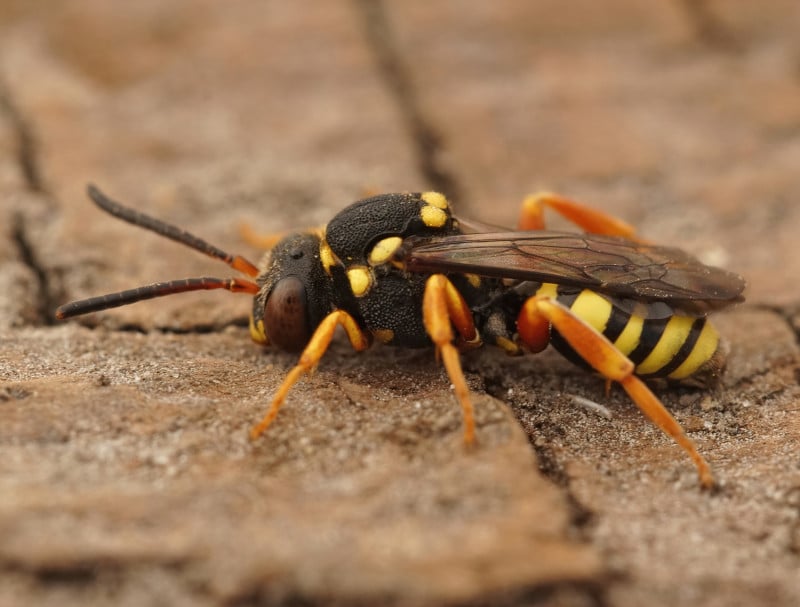
The Blunthorn Bees are a part of the Melittidae family and the Melitta species. There are around 50 of these species discovered globally. However, just four of them are known in the US and Canada, and four have been described in the UK.
They forage on a limited range of flowers. The American species, in particular, are incredibly useful pollinators of fruits like cranberries.
23. Lesser Mason Bees
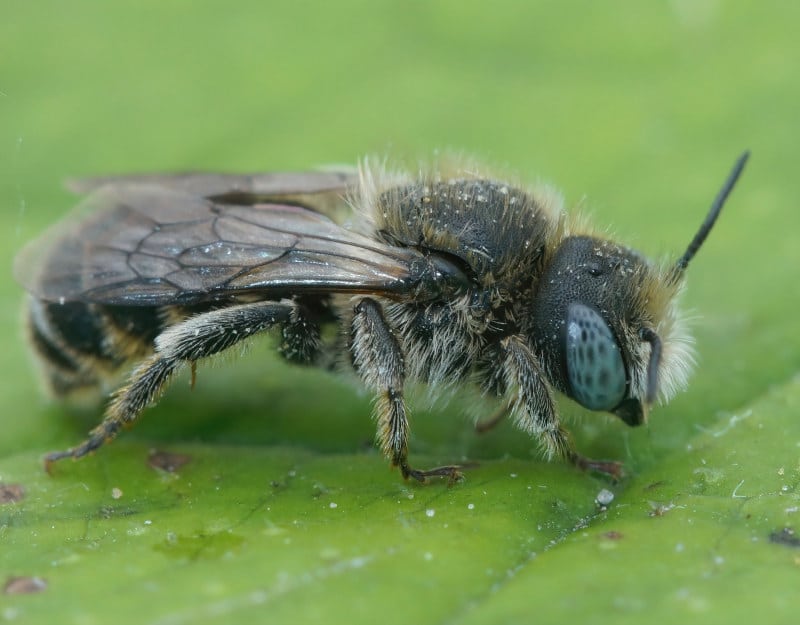
We’ve told you about Mason Bees. Now let’s touch on Lesser Mason Bees. They are members of the Megachilidae family and the Hoplitis species of bees.
These bees are one of the biggest of the species and are closely related to Osmia. They have very similar nesting and foraging behavior. The females have a cream-coloured pollen brush under their abdomen.
Males, on the other hand, have the tip of the front tibiae in a sharp, blunt point.
24. Oil-collecting Bees
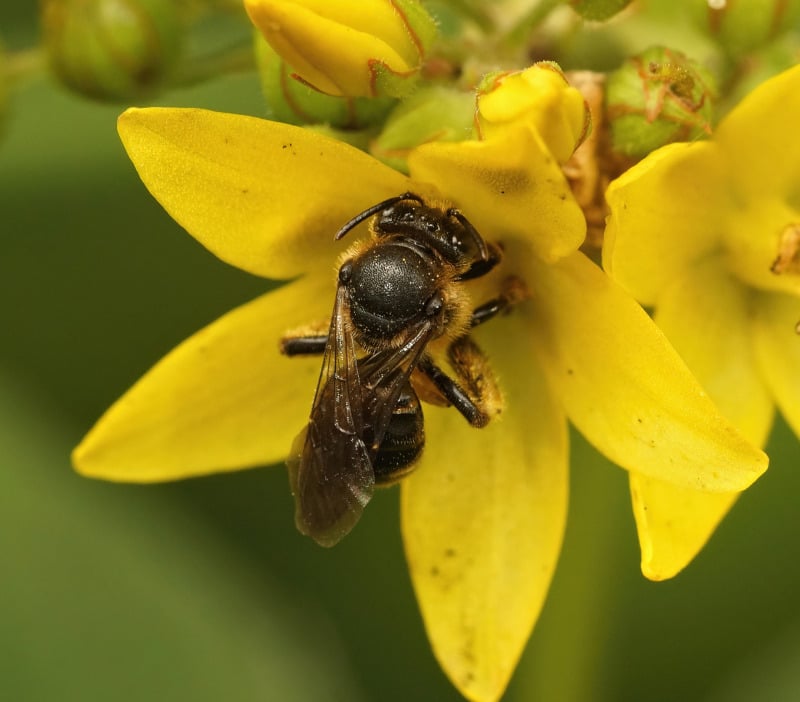
Just as the name suggests, these bees collect floral oils and pollen using specially adapted hairs on their back and front legs. They then use the oil to make their nests waterproof. They are associated commonly with Loosestrife flowers.
These bees are a part of the Melittidae family and the Macropis species. They are a bit darker in appearance than most bees, with very fine yellow stripe markings but mostly black. They have short hair and small bodies.
25. Base-banded Furrow Bees
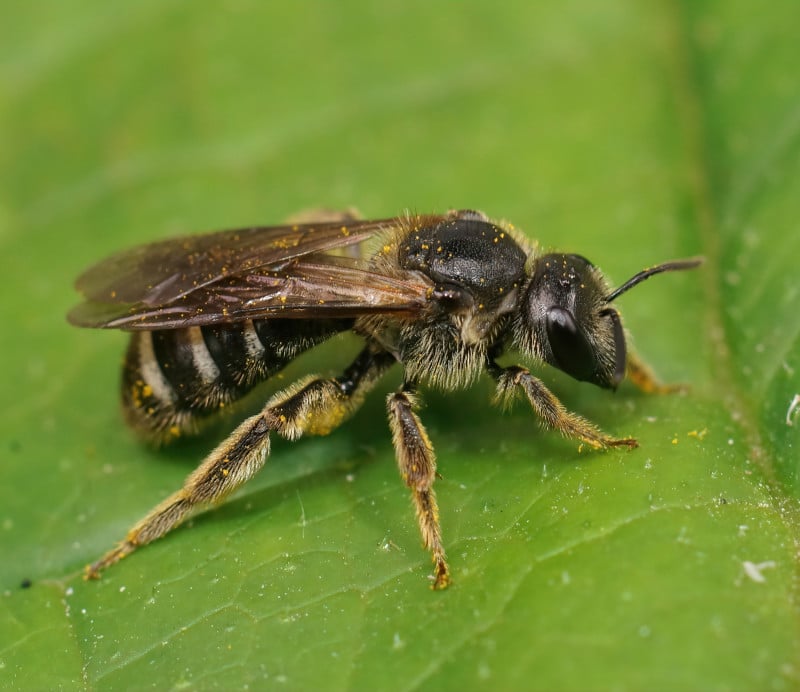
These bees are very distinctive-looking, once again being quite slender and darker in color. They range from very tiny to around the size of a Honey Bee. Most of them rest under the soil.
Apart from the Lasioglossum species, the world’s biggest species of bees with more than 1,700 species, they are also members of the Halictidae family. In some areas across the globe, they have also been given the nickname sweat bees as they are thought to collect human sweat.
What Is The Difference Between Bees And Wasps?
We kind of touched on this previously when we spoke about how to identify different types of bees, but there is a bit more to it than that. Wasps and bees are often confused with one another, but it is vital to understand the differences. For instance, wasps are very active in the summer months and have distinctive yellow and black coloring.
Bees, on the other hand, vary in color from almost black to golden brown and are much furrier than wasps. While both have a similar shape, their foraging and nesting behaviors also differ massively. Wasps find and live in one hole, whereas different bee species live differently. Whether that means in numerous hives, in wood, or under the soil.
Bees also do not eat any meat. Wasps are predators and feed on other insects. Wasps and bees both sting to protect themselves and their colony.
However, honey bees’ stingers, for example, are barbed. This means the stinger is torn from the bee’s abdomen and remains in the skin of the victim once stung.
Wasps can pull out their stinger and are capable of stinging more than one time without injuring themselves whatsoever.
Conclusion
Bees are a vital part of biodiversity, and we depend on them for our survival. The number of bee species in the world is incredible, and we wanted to take the time to appreciate them.
We hope this article helps you to easily identify the most common types of bees and to understand their importance in our society. Be sure to check out our articles on how to make a beautiful bee bath for your garden and how to create a sustainable bee-friendly garden for additional bee learning!